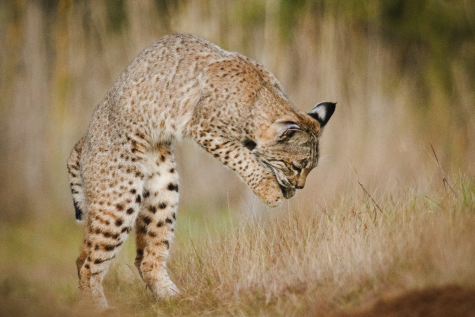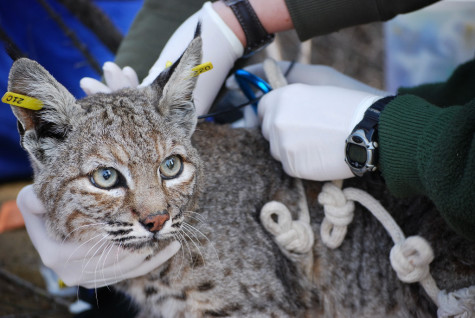If you were a bobcat, all tufted ears and oblique green eyes and lush spotted coat, you might find a lot to like about life in the Santa Monica Mountains. In the low, rugged range that bisects metropolitan Los Angeles, you would feast on the hordes of rats that frequent the unkempt middens of slovenly humans. You would exercise your formidable leaping skills to pluck fat squirrels from low-hanging oaks. And while along the mountains’ 46-mile length you could never travel more than a dozen or so miles in any direction without running up against a barrier — the nation’s busiest freeway, a shopping center, the ocean — you would hardly ever have to flee a predator. No creature but the odd mountain lion has it in for you. No human will stalk you with a gun or lay out a trap for your fur.
Which doesn’t mean we won’t kill you. It just means that, when we do, we don’t mean to. And most of the time, we won’t even know we did it.
During the period from 2002 to 2005, for instance, an infestation of notoedric mange tore through the bobcat population in the Santa Monicas, ultimately reducing its population by half. Among the cats that lived north of the 101 Freeway, which connects Los Angeles with the cities of Ventura County, the decline was more like 90 percent. You might doubt that humans bear much responsibility for the outbreak — mange spreads quickly among cats; humans don’t carry it — but the disease might have an oblique human connection. Almost all the bobcats that die from mange in the Santa Monicas turn out to have been exposed to poisons used to control rats. Specifically, rodenticides that interrupt the blood’s clotting mechanism, causing the affected animal to bleed to death internally.
Wildlife ecologist Laurel Klein Serieys began investigating the link between anti-coagulant rat poisons and mange while she was a graduate student at the University of California Los Angeles. At 35 years old, she finished her PhD last year and flew off to South Africa to study another tufty-eared wildcat, the caracal. But she hasn’t put aside her work on the Santa Monicas’ bobcats. The most recent study on which Serieys is the lead author looks at how life near the city influences bobcat genetics: How isolation, habitat fragmentation and disease lead to genetic drift and bottlenecks. Drawing upon bobcat blood, tissue and scat she and other researchers collected from 1996 through 2012, she studied regions across the bobcat genome to understand the terms of the animal’s survival on the edge of a major metropolis.
Some of the results were predictable. Bobcats in the wild western Santa Monicas were genetically different from bobcats in the congested east, who wend their way through the swimming pools of movie stars in the increasingly mansionized Hollywood Hills. (In isolation, inbreeding happens.) Some migrants traveled from east to west, but none traveled from open space to a more fragmented area.
Other results, on the other hand, came as a surprise. When Serieys compared DNA from cats before the mange outbreak with DNA from the animals that came after it, especially in the hard-hit population north of the 101 Freeway, she found what she calls “a story of resilience despite extreme demographic reduction.” While genetic markers that don’t matter much to a species’ survival — DNA found at neutral loci — showed a 10-fold increase in inbreeding indicators post-disease, suggesting a severely limited post-disease gene pool, genetic markers that have to do with the immune system, which matter a lot, showed astonishing diversity. Inbreeding indicators at the immune-linked loci, in fact, had actually decreased. By half. In a single generation.
“It suggests that natural selection occurred,” Serieys says. “Certain individuals who had more variation at some of the gene markers were able to survive longer in the face of the mange.” The genetic differences didn’t make future generations of bobcats immune to mange. It just “helped them persist long enough to contribute more offspring to the future generations.
“Because that’s what fitness means, doesn’t it?” Serieys says. “How many offspring you contribute to future generations. And where it matters — which in this case it was at immune regions — there were certain things that allowed certain individuals to have better reproductive success.”
Scientific papers don’t allow for much celebration; you can’t detect between the lines of Serieys’ study that at some point she might have been jumping up and down with joy. But over Skype from her location on the South African Cape Peninsula, I could detect a certain scientific enthusiasm. “How often to you get to document natural selection happening in a free-ranging population on such a short time scale?” she said. “How many scientific studies look for that and don’t find it?”
“The Beak of the Finch?” I offered, referring to Jonathan Weiner’s Pulitzer Prize-winning book about a science family studying evolution on the Galapagos Islands. “Right,” Serieys said. “And that’s an iconic study. It’s in all the textbooks. It goes to show how rare it is to observe natural selection in a single generation.” Urban ecologies being understudied, such a result has never been observed in urban system. “It is,” she said, “an exciting finding.”
And a hopeful one, although she cautioned that we shouldn’t be too cavalier. While the take-home message is one of resilience, Los Angeles still needs wildlife passages across those freeways. “It’s important to maintain connectivity between populations when they’re stressed by these various factors,” Serieys said.
Next up: Serieys will drill down even deeper into the relationship between anti-coagulant rodenticides and feline mange, and perhaps get beyond correlation to cause. “I’m working on that paper right now,” she told me. “Literally — I just did some data analysis today.” She had previously hypothesized that blood thinners suppressed immune function in cats, thereby making them more vulnerable to the “sublethal effects” of rat poisons. But her early findings show the opposite is true: Anti-coagulants actually increase white blood cell production, putting the immune system into overdrive.
“That increased immune stimulation as a result of anti-coagulant exposure could — and that could is very important — explain increased susceptibility to mange. But that,” she said, “is all I can say for now.”
Pouncing bobcat photo by Barry Rowan, courtesy National Park Service. Bobcat enduring the tagging process from the National Park Service via Flickr.


2 thoughts on “Guest Post: The Resilience of The Citified Bobcat”
Comments are closed.